Abstract
High-density polyethylene (HDPE) is a widely used polymer known for its excellent mechanical properties and chemical resistance. This study investigated the impact of incorporating varying percentages of nano-graphene particles (NGP) into HDPE on its thermal, mechanical, and tensile properties. Differential scanning calorimetry (DSC) analysis revealed that the addition of NGP enhanced the thermal stability and crystallization behavior of HDPE, with optimal performance observed at a 5% NGP concentration. Mechanical property evaluations indicated that small additions of NGP initially reduced zero-shear viscosity from 114,667 Pa·s to 44,045 Pa·s at 1% NGP, but higher concentrations improved the material’s rigidity and strength, with the best results at 3% NGP, where the flexural modulus reached 980 MPa. Tensile tests showed that while small amounts of NGP may decrease tensile strength from 26.4 MPa to 23.5 MPa at 1% NGP, higher concentrations significantly enhanced these properties, with tensile strength at break reaching 27 MPa and tensile elongation peaking at 20.8% at 7% NGP. The findings highlight the potential of NGP to enhance the performance of HDPE composites, making them suitable for a wide range of industrial applications. These enhanced composites are particularly important for the bottling industry, where improved material properties can lead to lighter, stronger, and more efficient packaging solutions.
1. Introduction
Polymers and polymer-based composites have sparked widespread interest over the years due to their unique and desirable properties, such as their ease of processing, their light weight, and their low cost [1,2]. These properties have pushed to replace many conventional materials in various applications, including medicine, aerospace, appliances, food processing and preservation, and many others [3,4]. Several research studies have been undertaken to change the characteristics of polymer composites using natural or synthetic components, such as fillers and fibers [5,6].
High-density polyethylene (HDPE) is a flexible and adaptable thermoplastic polymer produced from the ethylene monomer. HDPE has a remarkable strength-to-density ratio, making it robust, relative to its mass [7]. HDPE is extensively used in the manufacturing of plastic bottles because of its exceptional durability [8]. Furthermore, HDPE is very suitable for transporting water supply and sewage in industrial applications because of its outstanding resistance to corrosion and various solvents [9]. In contrast to low-density polyethylene (LDPE), HDPE exhibits greater rigidity and opacity and can endure temperatures of around 120 °C for brief durations [10,11]. From an environmental standpoint, HDPE’s recyclability and reduced carbon footprint make it a sustainable option [12].
Nowadays, most researchers combine polymeric materials with carbon or metallic nanomaterial additives to enable them to meet new demands from industry and to reduce costs [13]. The selection of reinforcements in polymeric composites has shown itself to be significant for obtaining the required properties for specific designs, which explains why studying these reinforcements is important. Many researchers have paid great attention to the mechanical properties of polymeric composites [14]. Nano-graphite particles (NGPs) are minuscule, planar graphene nanoplatelets that exhibit distinctive characteristics such as exceptional electrical and thermal conductivity, mechanical robustness, and a substantial surface area [15]. Mingione, E. et al. [16] investigated the thermal, electrical, and tribological performances of graphite nanoplatelets/Polyamide-12 composites produced by selective laser sintering. The findings of the study indicated that an increase in the dispersion of GnPs particles within the matrix resulted in a hydrophobic surface behavior. Moreover, significant enhancements were observed in electrical conductivity (10-7) and thermal performance (33.6%). Tribological tests showed a 25% decrease in the friction coefficient and an 80% improvement in wear resistance, compared to the PA-12 matrix.
Using NGPs in bottle production may significantly strengthen plastic bottles’ barrier characteristics, increasing their resistance to gas and moisture [17]. This, in turn, aids in preserving the freshness and shelf-life of drinks. Furthermore, NGPs enhance the mechanical robustness and longevity of bottles, decreasing breakage and improving the overall quality [18]. Furthermore, their high thermal conductivity facilitates the use of more effective manufacturing techniques, hence possibly reducing both production expenses and energy consumption [16,19].
On other hand, in relation to graphite as a filler material for polymer composites, there was a significant reduction in the tensile strengths of different polymer composites such as PPE [20], EVA [21], PMMA [22], HDPE [23], and PLA [24], especially at 4 wt.% of graphite and higher. Also, those studies revealed that the mechanical behavior of the graphite/polymer composite depends on the interaction, the distribution, the size, and the orientation of the graphite [25].
Combining HDPE with nano-graphite particles (NGPs) in polymer manufacturing brings notable benefits. HDPE is favored for its strength, durability, and chemical resistance, making it ideal for plastic containers. When NGPs are added to HDPE, the composite gains the unique advantages of NGPs, including high electrical and thermal conductivities, mechanical strength, and a large surface area [26]. This combination improves the bottles’ barrier properties, enhancing their resistance to gas and moisture, which is essential for preserving beverages’ freshness and shelf-life. Additionally, the mechanical strength and durability of the bottles are increased, reducing breakage and improving overall quality [27]. The thermal conductivity of NGPs also supports more efficient manufacturing processes, potentially lowering production costs and energy usage. Overall, the HDPE–NGP composite marks a significant advancement in bottle manufacturing, offering enhanced performance and sustainability [28].
The market for bottles of HDPE and composites is experiencing significant growth. In 2023, the global HDPE bottle market was valued at approximately USD 53 billion and is projected to reach USD 74.7 billion by 2033, growing at a compound annual growth rate (CAGR) of 3.5% [18,29]. The broader HDPE market, which includes various applications beyond bottles, was valued at USD 91.73 billion in 2022 and is expected to grow to USD 145.5 billion by 2027, with a CAGR of 9.6%. This growth is driven by increasing demand for sustainable packaging solutions, HDPE’s versatility in various consumer goods, and the rising e-commerce sector, which benefits from HDPE’s durability and resistance to damage during transit [30].
This study aims to evaluate the impacts of different NGP loadings on the thermal, mechanical, and tensile properties of HDPE. By conducting a series of differential scanning calorimetry (DSC) analyses, mechanical property evaluations, and tensile tests, we seek to identify the optimal NGP concentrations that maximize the performance of HDPE composites. The findings from this research will provide valuable insights into the development of advanced HDPE composites with enhanced properties, particularly for applications in the bottling industry, where improved material performance can lead to lighter, stronger, and more efficient packaging solutions.
2. Materials and Methods
2.1. Materials
To prepare the composite material, high-density polyethylene copolymer (HDPE) blow molding resin EMDA-6147, which has a melting point of Tm 131 °C, tensile strength at a yield of 26 MPa, and an ultimate tensile strength of 35 MPa, was provided. Pentaerythritol-tetrakis3-(3,5-DTB-4HP) propionate (IRG1010) and tris (2,4-DTB) phenyl phosphite (IRG168), supplied from EQUATE petrochemical company, Kuwait, were mixed with nano-graphite particles (NGPs) black powder, which had a diameter size range of ~0.5–25 µm, and the purity of the graphite varied from 95% to 99.9%. Carbon and oxygen content (wt.%) was 12 ± 3, with Scott density ranging from 0.05–0.16 g/cm3 and surface area ranging from 200 ± 50 m2/g, with the thickness in nanometer (nm) being ~4. NGPs at different percentages acted as an additive. The latter was purchased from NeoGraf Solutions, LLC, Lakewood, OH, USA.
2.2. Preparation of Raw Materials
In this investigation, the composite material used in the bottle manufacturing process was nano-graphite powder (NGP) as an additive at different percentages (0, 1, 3, 5, and 7 wt.%) in high-density polyethylene (HDPE), as presented in Figure 1 and illustrated in Table 1.
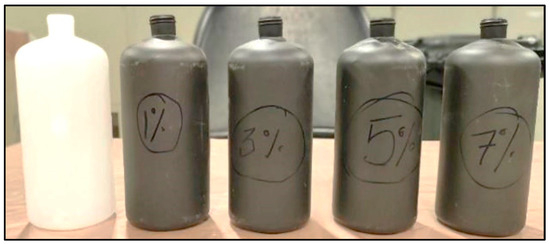
Figure 1.
Photograph of the manufactured HDPE bottles (from left to right) with 0, 1, 3, 5, and 7 wt.% NGP, respectively.

Table 1.
Sample preparation.
Samples were mixed with HDPE polymer base resin and blended in a Tumbling Blender Model (PMDM50), a precise blender for homogeneous mixing. Then, they were melted and extruded into pellets using a Killion KN-150 compounding pelletizer, and the parameters for all samples are presented in Table 2. Bottles were produced using a Bekum BM-206-DE blow molding machine, and later, samples were prepared and tested. Every sample test was repeated three times in this research, and the average measurement was obtained.

Table 2.
Killion single-screw extruder parameters.
2.3. Material Characterization
2.3.1. Melt Flow Index (MFI) Test
The melt flow index (MFI) (Tinius Olsen-MP 993, Horsham, PA, USA) measures the ease of flow of melts of a thermoplastic polymer and observes pellet characteristics at various HDPE and NGP composite percentages. Following ASTM standard D 1238-04 and ISO standard 1133, the melt inclusion temperature was established at 190 °C, while the pellet density temperature was 23 °C. Oxidative induction time (OIT) and bulk density were also noted. Upon the solidification of a polymer matrix, it may retain minute cavities of molten material, a process referred to as melt inclusion (MI). The introduction of contaminants into a polymer during processing methods, such as extrusion or molding, may modify the material’s mechanical and thermal properties. MI may act as stress concentrators, resulting in reduced mechanical strength and increased brittleness.
2.3.2. Differential Scanning Calorimetry (DSC) Test
The thermal characteristics of HDPE incorporating 0, 1, 3, 5, and 7 wt.% NGP samples were examined utilizing DSC Q20 (TA Instruments, New Castle, DE, USA). Throughout the experiment, samples weighing 5–7 mg were meticulously measured and positioned within an aluminum pan for analysis, safeguarded by high-purity nitrogen. At the same time, the rates of heating and cooling were calibrated to 10 °C/min. The sample was heated at 200 °C to melt it completely, removing any thermal history effects. It was cooled to 40 °C to generate a crystallization process curve, followed by reheating to 200 °C to derive a melting curve.
2.3.3. Rheology Properties Test
A rotational rheometer named ARES-G2 (TA Instruments, USA) was utilized to obtain the rheological properties, such as zero shear viscosity, molecular weight, cross modulus (G’), and a polydispersity index (PDI).
2.3.4. Bottle Weight and Wall Thickness Test
A precise balance instrument (Mettler Toledo-PB 4002-S, Columbus, OH, USA) was utilized to weigh the HDPE and NGP composites and the manufactured bottles at different composite percentages.
2.3.5. Top Load Test
The data were recorded using a computer software (Nexygen-4.6; Lloyd Instruments), and all bottle samples were affixed to a computer-controlled materials testing device (Model LRX-plus; Lloyd Instruments Ltd., Fareham, UK) with a 1 KN load cell. An aluminum circular slotted compression plate was used, which allowed the air to escape from the bottles during the test. By applying a downward compressive force to a bottle sample and measuring its resistance to deformation while moving at a speed of 0.5 mm/min, the compressive force was used to find the crushing yield load. The load required for the crush yield was recorded in Newtons.
2.3.6. Flexural Testing and Tensile Testing
Flexural and tensile properties were determined according to ASTM D790 and ASTM D638, respectively, under ambient conditions, using Instron 4465.
3. Results and Discussion
3.1. Melt Flow Index (MFI)
It was observed that melt inclusion (MI) and density increased with the increase in the loading of NGP percentage into HDPE. Table 3 shows the melt inclusion (MI) at 190 °C per 5.0 g per 10 min, equal to 0.48 in the control sample, and it increased to 0.5, 0.51, and 0.55 at 1%, 3%, and 5% NGP, respectively, due to the higher density of the NGP. In sample five, the HDPE with 7% NGP exhibited a decrease in melt inclusion (MI) at both 5 and 21.6 g/10 min as follows: 0.53 and 10.45, respectively. In addition, the bulk density of sample one, where the HDPE was in its pure condition, was equal to 0.5012 g/cc. It was observed that adding NGP to the HDPE increased the bulk density as follows: 0.5519, 0.05521, 0.5540, and 0.5578 for samples 2, 3, 4, and 5, respectively. Moreover, the data clearly showed the relationship between the percentage of NGP added to the HDPE and the increase in oxidative induction time (OIT); for instance, in sample one, where no NGP was added, the oxidative induction time (OIT) value was 16.5 and increased to 17.1 and 17.3 in samples two and three, where the addition percentages of the NGP were 1% and 3%, respectively.

Table 3.
Pellet properties.
3.2. Differential Scanning Calorimetry (DSC)
The differential scanning calorimetry (DSC) curves for high-density polyethylene (HDPE) with varying percentages of nano-graphene particles (NGP) revealed significant insights into the thermal behavior of the material.
The findings of the DSC analysis of the pure HDPE and HDPE composites are shown in Figure 2. As a result of the different composite percentages, it was noticed that there was only one melting peak and one crystallization peak during the heating curve and the cooling curve, respectively. In light of these findings, it was determined that the formation of crystals in the composite system was quite simple and that no new forms of crystals presented themselves. Table 4 provides characteristic data of HDPE–NGP composites in melting and crystal curves, such as the melting temperature (Tm), the heat of fusion (ΔHf), the crystallization temperature (Tc), and the crystallization enthalpy (ΔHc), respectively.
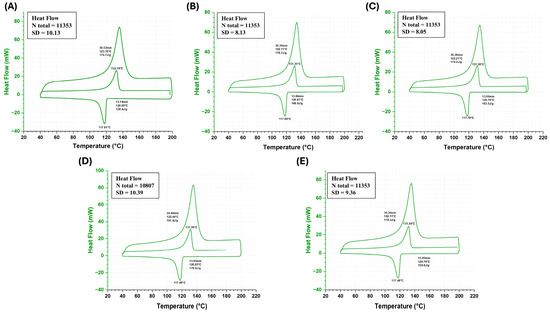
Figure 2.
DSC curves and standard deviation (SD) of HDPE with (A) 0% NGP, (B) 1%NGP, (C) 3% NGP, (D) 5% NGP, and (E) 7% NGP.

Table 4.
Characteristic data of HDPE–NGP composites in melting and crystal curves.
The temperature in sample one, as a pure HDPE, equaled 132.19 °C and was reduced to 131.35 °C when 1% of NGP was added in sample two. Also, it is clearly shown that the Tm increased as the percentage of NGP increased in the HDPE from sample two to sample five, respectively. The ΔHf increased as the NGP percentage increased, with the lowest value found in sample one equal to 170.7 (j/g) and the highest value achieved in sample four equal to 197.4 (j/g); this was mainly attributed to the dilution effect of the NGP powder within the HDPE matrix, which affected the melting of the HDPE [31]. Furthermore, the crystallization temperature (Tc) was almost the same in all samples, with a slight variation. The highest value was 117.89 in sample one, and the lowest was 117.48 in sample five. In addition, the crystallization enthalpy (ΔHc) increased slightly with the increase in the NGP percentage in the HDPE composite, except in samples three and five, where the ΔHc dropped to 163.5 and 150.8 (j/g), respectively. This indicates that the addition of NGP enhanced the thermal stability and crystallization behavior of HDPE, making it more resistant to thermal degradation and improving its overall thermal performance.
3.3. Rheology Properties
Figure 3 presents the rheology of pure HDPE and the composite at different percentages, also illustrating the effect of composite content on zero-shear viscosity. It was noted that the filler loading was observed to have more impact on the shear viscosity, as shown in sample one, which was pure HDPE with a value of 100,400 Pa·s, which dropped to 45,346 Pa·s in sample two, where NGP 1% was added, and increased to 46,700,47,320, and 48,270 Pa·s in samples three, four, and five, respectively. This trend suggests that small amounts of NGP reduce viscosity, possibly due to improved dispersion and lubrication effects. However, higher concentrations may lead to increased viscosity due to particle–particle interactions and agglomeration.
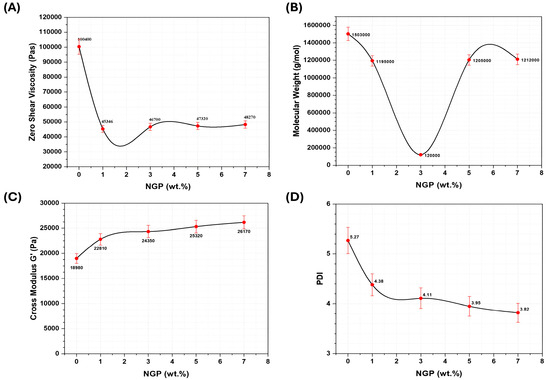
Figure 3.
Impact of loading different percentages of NGP in HDPE on (A) zero-shear viscosity, (B) molecular weight, (C) cross modulus (G’), and (D) polydispersity index (PDI).
Moreover, in the molecular weight scenario, as demonstrated in Figure 3B, the pure HDPE had the highest molecular weight at 1,503,000 g/mol. It decreased to 1,195,000 g/mol when 1% NGP was added to HDPE and sharply dropped to 120,000 g/mol in sample three. Then, when the NGP content increased to 5% and 7%, it increased to 1,205,000 and 1,212,000 g/mol, respectively. This indicates that the presence of NGP initially causes chain scission or degradation, reducing the molecular weight. However, at higher concentrations, the NGP may act as a nucleating agent, promoting polymerization and increasing the molecular weight.
In addition, Figure 3C illustrates the impact of NGP percentage content on HDPE cross modules (G’). In sample one, where no NGP was added, the G’ value was 18,980 Pa and increased to 22,810, 24,350, 25,320, and 26,170 Pa when the NGP percentage content increased to 1%, 3%, 5%, and 7% in HDPE, respectively. This increase in G’ indicates that the material becomes stiffer and more rigid with the addition of NGP, likely due to the reinforcing effect of the graphene platelets, which enhanced the mechanical properties of the polymer matrix.
In contrast, the polydispersity index peak was observed in the pure HPDE sample with a value of 5.27 and started to decline when NGP content was added to 1% NGP; the PDI value decreased to 4.38, 4.11, 3.95, and 3.82 at 3%, 5%, and 7% NGP, respectively. A lower PDI indicates a more uniform molecular weight distribution, suggesting that the addition of NGP leads to a more homogeneous polymer structure, possibly due to the nucleating effect of the graphene particles, which promotes uniform polymerization.
3.4. Bottle Weight and Wall Thickness
The impact of loading different percentages of nano-graphene particles (NGP) in high-density polyethylene (HDPE) on bottle weight is illustrated in Figure 4. The data showed a clear trend of decreasing bottle weight and wall thicknesses of manufactured bottles with increasing NGP content as shown in Table 5. At 0% NGP, the bottle weight was approximately 34.3 g. As the NGP content increased to 1%, the bottle weight decreased to around 32.1 g. This trend continued with 3% NGP, where the weight further reduced to about 29.6 g. At 5% NGP, the bottle weight dropped to approximately 26.2 g, and the lowest weight was observed at 7% NGP, where the bottle weighed around 24.1 g.
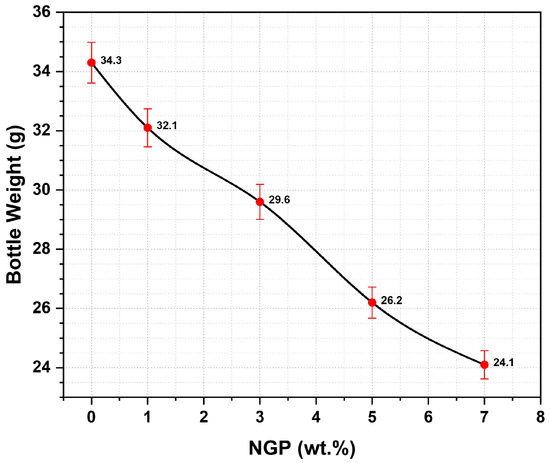
Figure 4.
Impact of loading different percentages of NGP in HDPE on the bottle weight, in (g).

Table 5.
The wall thicknesses of manufactured bottles at different NGP percentages in HDPE.
This reduction in bottle weight with increasing NGP content can be attributed to the reinforcing effect of NGP on the HDPE matrix. The addition of NGP enhanced the mechanical properties of HDPE, allowing for the use of less material while maintaining or even improving the strength and durability of the bottles. NGPs likely enhanced the load-bearing capacity and stiffness of the HDPE, contributing to overall weight reduction. This is particularly beneficial for applications where weight reduction is crucial, such as in packaging and transportation, leading to cost savings and increased efficiency.
Furthermore, the incorporation of NGP into HDPE yielded lighter bottles, with the most significant weight reduction observed at a 7% NGP content. This finding highlights the potential of NGP to enhance the performance of HDPE for various applications. The ability to reduce material usage while maintaining or improving mechanical properties can lead to more sustainable and cost-effective solutions in the production of HDPE-based products. Further research could investigate the optimal loading of NGP to strike a balance between weight reduction and other desirable properties, such as impact resistance and thermal stability.
3.5. Top Load Test
Figure 5 illustrates the effect of loading different percentages of nano-graphene platelets (NGP) in high-density polyethylene (HDPE) on the crushing yield load, measured in Newtons (N). The x-axis represents the weight percentage of NGP, ranging from 0% to 7%, while the y-axis shows the crushing yield load, ranging from 550 to 630 N. The data points indicate that at 0% NGP, the crushing yield load was approximately 620 N. As the percentage of NGP increased to 1%, there was a slight increase in the crushing yield load to around 622 N. However, further increasing the NGP content resulted in a significant decrease in the crushing yield load; at 3% and beyond, there was a notable drop, with values being around 570 N at 3% and slightly lower at around 567 N at 5%. The lowest value observed was approximately 551 N at an addition of about 7% NGP.
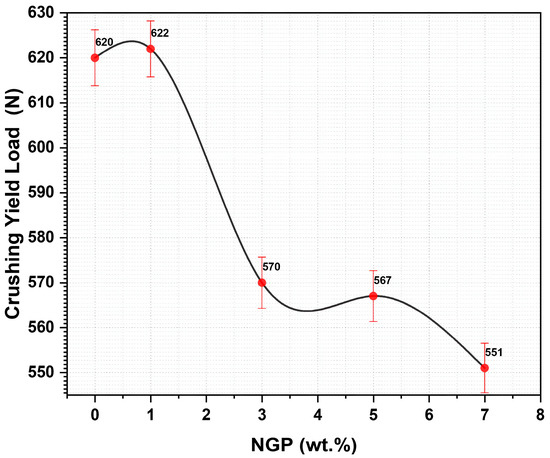
Figure 5.
The effects of loading different percentages of NGP in HDPE on the crushing yield load, in Newtons.
The initial slight increase in the crushing yield load at 1% NGP suggests that small additions of NGP can enhance the mechanical strength of HDPE. This improvement can be attributed to the reinforcing effect of well-dispersed NGP within the polymer matrix, which enhanced the material’s load-bearing capacity. However, as the NGP content increased beyond 1%, the crushing yield load decreased significantly. This reduction in mechanical strength at higher NGP concentrations may be attributed to the agglomeration or poor dispersion of nanoparticles within the HDPE matrix, resulting in defects and weak points that compromise the material’s structural integrity under compressive loads.
In summary, incorporating up to 1% NGP into HDPE can slightly improve its compressive strength properties, as indicated by the higher crushing yield load. However, higher concentrations of NGP lead to diminishing returns and even detrimental effects on the material’s performance under compression tests. The significant decrease in crushing yield load beyond 1% NGP highlights the importance of optimizing the dispersion and concentration of NGP to achieve the desired mechanical properties. These findings underscore the need for careful consideration of NGP loading levels to balance the benefits of reinforcement with the potential drawbacks of nanoparticle agglomeration.
3.6. Flexural Testing
Figure 6 illustrates the impact of loading different percentages of nano-graphene platelets (NGP) in high-density polyethylene (HDPE) on the flexural modulus, measured in megapascals (MPa). The data points indicate that the flexural modulus of HDPE initially decreased slightly from 971 MPa at 0% NGP to 960 MPa at 1% NGP. However, as the NGP content increased to 3%, the flexural modulus rose to 980 MPa, indicating an improvement in the material’s stiffness. Beyond this point, the flexural modulus decreased again, reaching 967 MPa at 5% NGP and further dropping to 942 MPa at 7% NGP.
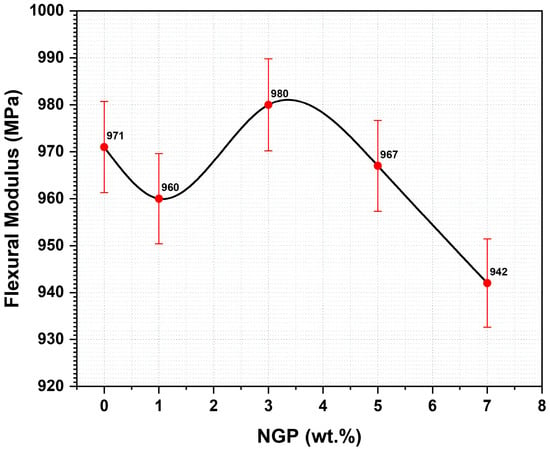
Figure 6.
The impacts of loading different percentages of NGP in HDPE on the flexural modulus, in MPa.
The initial decrease in the flexural modulus at 1% NGP suggests that small additions of NGP may not significantly enhance the stiffness of HDPE. However, the increase observed at 3% NGP indicates that this concentration provides an optimal reinforcement effect, improving the material’s rigidity. The subsequent decrease in the flexural modulus at higher NGP concentrations (5% and 7%) may be attributed to the agglomeration or poor dispersion of the nanoparticles within the HDPE matrix. This poor dispersion can lead to a reduction in the reinforcing effect and potentially introduce defects that compromise the material’s mechanical properties.
In summary, the data suggest that the optimal loading of NGP for enhancing the flexural modulus of HDPE is around 3%. At this concentration, the material exhibits the highest stiffness, which can be beneficial for applications requiring improved rigidity. However, higher concentrations of NGP may lead to diminishing returns and even detrimental effects on the flexural properties of HDPE. These findings highlight the importance of optimizing NGP dispersion and concentration to achieve the desired mechanical performance in HDPE composites. Further research could explore methods to enhance nanoparticle dispersion and investigate the impacts of various types of graphene-based fillers on the mechanical properties of HDPE.
3.7. Tensile Properties
Figure 7 presents the impacts of loading different percentages of (NGP) in high-density polyethylene (HDPE) on various tensile properties. The data revealed that the tensile strength (Figure 7A) initially decreased from 26.4 MPa at 0 wt.% NGP to a minimum of 23.5 MPa at around 1 wt.% NGP. However, as the NGP content increased, the tensile strength gradually improved, reaching approximately 24.3 MPa at 7 wt.% NGP. This trend suggests that small additions of NGP may initially weaken the HDPE matrix, possibly due to poor dispersion or agglomeration, but higher concentrations lead to better reinforcement and improved tensile strength.
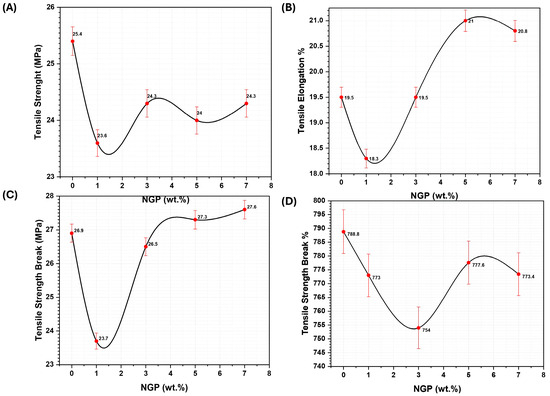
Figure 7.
HPDE with different percentages of NGP Vs. (A) Tensile strength (MPa), (B) tensile elongation %, (C) tensile strength break (MPa), and (D) tensile strength break % subsection.
In terms of tensile elongation (Figure 7B), the data showed a decrease from about 19.5% at 0 wt.% NGP to a minimum of around 18.2% at approximately 1 wt.% NGP. However, as the NGP content increased further, the tensile elongation significantly improved, peaking at about 20.8% around 6–7 wt.% NGP. This indicates that while small amounts of NGP may reduce the ductility of HDPE, higher concentrations enhance the material’s ability to elongate under tensile stress, likely due to the better interaction and dispersion of NGP within the polymer matrix.
The tensile strength at break (Figure 7C) followed a similar trend to the tensile strength, initially decreasing from approximately 26.9 MPa at 0 wt.% NGP to a minimum value of around 23.7 MPa at 1 wt.% NGP. It then increased, reaching approximately 27 MPa at higher NGP percentages. The tensile strength break percentage (Figure 7D) started high, near approximately 788%, dropped to a low point near roughly 745–750%, and then rose again, peaking close to 775–780%, before slightly decreasing again towards the end. These trends suggest that while small additions of NGP may initially weaken the HDPE, higher concentrations improve both the tensile strength and elongation at break, indicating enhanced mechanical properties and better overall performance of the composite material.
4. Conclusions
In conclusion, the findings in this study provide a comprehensive understanding of the impacts of loading different percentages of nano-graphene particles (NGP) in high-density polyethylene (HDPE) on its thermal, mechanical, and structural properties. The differential scanning calorimetry (DSC) curves indicated that the addition of NGP enhanced the thermal stability and crystallization behavior of HDPE, with the most significant improvement observed at a 5% NGP concentration. Beyond this concentration, the thermal properties did not show further enhancement, suggesting an optimal loading level for thermal performance.
The mechanical properties, as illustrated by the zero-shear viscosity, molecular weight, cross modulus, and polydispersity index, revealed that small additions of NGP can initially reduce viscosity and molecular weight, likely due to chain scission or degradation. However, higher concentrations improved the mechanical strength and rigidity of HDPE, with the cross modulus showing a significant increase. Optimal mechanical performance was observed at around 3% NGP, where the material exhibited the highest flexural modulus, indicating enhanced stiffness.
The tensile properties, including tensile strength, tensile elongation, and tensile strength at break, demonstrated that small additions of NGP may initially weaken the HDPE matrix. However, higher concentrations led to improved tensile properties, with the most significant enhancements observed at a 7% NGP concentration. This suggests that while small amounts of NGP may reduce ductility, higher concentrations enhance the material’s ability to withstand tensile stress and elongation, indicating better overall performance.
Finally, the incorporation of NGP into HDPE significantly enhanced its thermal, mechanical, and tensile properties, with optimal performance observed at specific loading levels. The findings highlight the importance of optimizing NGP dispersion and concentration to achieve the desired balance of properties for various applications. These results highlight the potential of NGP to enhance the performance of HDPE composites, making them suitable for a broad range of industrial and commercial applications. Further research is recommended to explore methods for improving nanoparticle dispersion and to investigate the effects of varying graphene-based filler concentrations on the properties of HDPE.
Author Contributions
Conceptualization, A.S.; Methodology, H.A.A. and S.A.A.; Software, H.A.A.; Validation, H.A.A.; Formal analysis, A.S. and H.A.A.; Investigation, S.A.A.; Data curation, H.A.A. and S.A.A.; Writing—original draft, A.S.; Supervision, A.S. All authors have read and agreed to the published version of the manuscript.
Funding
This research received no external funding.
Data Availability Statement
The original contributions presented in this study are included in the article. Further inquiries can be directed to the corresponding author.
Acknowledgments
We would like to acknowledge the technical support provided by the R&D management of EQUATE Petrochemical Company, which has supported Kuwaiti researchers.
Conflicts of Interest
The authors declare no conflicts of interest. The funders had no role in the design of the study; in the collection, analyses, or interpretation of data; in the writing of the manuscript; or in the decision to publish the results.
References
- Hsissou, R.; Seghiri, R.; Benzekri, Z.; Hilali, M.; Rafik, M.; Elharfi, A. Polymer composite materials: A comprehensive review. Compos. Struct. 2021, 262, 113640. [Google Scholar] [CrossRef]
- Shalwan, A.; Alajmi, A.; Yousif, B. Theoretical study of the effect of fibre porosity on the heat conductivity of reinforced gypsum composite material. Polymers 2022, 14, 3973. [Google Scholar] [CrossRef] [PubMed]
- Samir, A.; Ashour, F.H.; Hakim, A.A.A.; Bassyouni, M. Recent advances in biodegradable polymers for sustainable applications. npj Mater. Degrad. 2022, 6, 68. [Google Scholar] [CrossRef]
- Alajmi, A.; Abousnina, R.; Shalwan, A.; Alajmi, S.; Alipour, G.; Tafsirojjaman, T.; Will, G. An experimental and numerical investigation into the durability of fibre/polymer composites with synthetic and natural fibres. Polymers 2022, 14, 2024. [Google Scholar] [CrossRef] [PubMed]
- Alenezi, H.; Cam, M.E.; Edirisinghe, M. Experimental and theoretical investigation of the fluid behavior during polymeric fiber formation with and without pressure. Appl. Phys. Rev. 2019, 6, 041401. [Google Scholar] [CrossRef]
- Alenezi, H.; Cam, M.E.; Edirisinghe, M. Core–sheath polymer nanofiber formation by the simultaneous application of rotation and pressure in a novel purpose-designed vessel. Appl. Phys. Rev. 2021, 8, 041412. [Google Scholar] [CrossRef]
- Kanagaraj, S.; Varanda, F.R.; Zhil’tSova, T.V.; Oliveira, M.S.; Simões, J.A. Mechanical properties of high density polyethylene/carbon nanotube composites. Compos. Sci. Technol. 2007, 67, 3071–3077. [Google Scholar] [CrossRef]
- Sciacovelli, A.; Navarro, M.; Jin, Y.; Qiao, G.; Zheng, L.; Leng, G.; Wang, L.; Ding, Y. High density polyethylene (HDPE)—Graphite composite manufactured by extrusion: A novel way to fabricate phase change materials for thermal energy storage. Particuology 2018, 40, 131–140. [Google Scholar] [CrossRef]
- Reports, M.I.I. HDPE Market Size & Share Analysis-Growth Trends & Forecasts (2024–2029). 2024. Available online: https://www.mordorintelligence.com/industry-reports/high-density-polyethylene-hdpe-market (accessed on 6 June 2025).
- Zhang, X.M.; Elkoun, S.; Ajji, A.; Huneault, M.A. Oriented structure and anisotropy properties of polymer blown films: HDPE, LLDPE and LDPE. Polymer 2004, 45, 217–229. [Google Scholar] [CrossRef]
- Sui, G.; Zhong, W.; Ren, X.; Wang, X.; Yang, X. Structure, mechanical properties and friction behavior of UHMWPE/HDPE/carbon nanofibers. Mater. Chem. Phys. 2009, 115, 404–412. [Google Scholar] [CrossRef]
- Li, X.; Mahadas, N.A.; Zhang, M.; DePodesta, J.; Stefik, M.; Tang, C. Sustainable high-density polyethylene via chemical recycling: From modification to polymerization methods. Polymer 2024, 295, 126698. [Google Scholar] [CrossRef]
- Pavlidou, S.; Papaspyrides, C. A review on polymer–layered silicate nanocomposites. Prog. Polym. Sci. 2008, 33, 1119–1198. [Google Scholar] [CrossRef]
- Alajmi, M.; Alrashdan, K.; Alsaeed, T.; Shalwan, A. Tribological characteristics of graphite epoxy composites using adhesive wear experiments. J. Mater. Res. Technol. 2020, 9, 13671–13681. [Google Scholar] [CrossRef]
- Bilisik, K.; Akter, M. Polymer nanocomposites based on graphite nanoplatelets (GNPs): A review on thermal-electrical conductivity, mechanical and barrier properties. J. Mater. Sci. 2022, 57, 7425–7480. [Google Scholar] [CrossRef]
- Mingione, E.; Salvi, D.; Almonti, D.; Ponticelli, G.S. Improvement of thermal, electrical, and tribological performances of GnPs composites produced by selective laser sintering. Polym. Compos. 2025, 46, 7924–7938. [Google Scholar] [CrossRef]
- Wu, F.; Misra, M.; Mohanty, A.K. Challenges and new opportunities on barrier performance of biodegradable polymers for sustainable packaging. Prog. Polym. Sci. 2021, 117, 101395. [Google Scholar] [CrossRef]
- Kim, S.; Do, I.; Drzal, L.T. Thermal stability and dynamic mechanical behavior of exfoliated graphite nanoplatelets-LLDPE nanocomposites. Polym. Compos. 2010, 31, 755–761. [Google Scholar] [CrossRef]
- Kausar, A. Avant-Garde polymer and Nano-graphite-derived nanocomposites—Versatility and implications. C 2023, 9, 13. [Google Scholar] [CrossRef]
- Celik, C.; Warner, S.B. Analysis of the structure and properties of expanded graphite-filled poly (phenylene ether)/atactic polystyrene nanocomposite fibers. J. Appl. Polym. Sci. 2007, 103, 645–652. [Google Scholar] [CrossRef]
- George, J.J.; Bhowmick, A.K. Ethylene vinyl acetate/expanded graphite nanocomposites by solution intercalation: Preparation, characterization and properties. J. Mater. Sci. 2008, 43, 702–708. [Google Scholar] [CrossRef]
- Ramanathan, T.; Abdala, A.A.; Stankovich, S.; Dikin, D.A.; Herrera-Alonso, M.; Piner, R.D.; Adamson, D.H.; Schniepp, H.C.; Chen, X.; Ruoff, R.S.; et al. Functionalized graphene sheets for polymer nanocomposites. Nat. Nanotechnol. 2008, 3, 327–331. [Google Scholar] [CrossRef] [PubMed]
- Zheng, W.; Lu, X.; Wong, S.C. Electrical and mechanical properties of expanded graphite-reinforced high-density polyethylene. J. Appl. Polym. Sci. 2004, 91, 2781–2788. [Google Scholar] [CrossRef]
- Narimissa, E.; Gupta, R.; Bhaskaran, M.; Sriram, S. Influence of nano-graphite platelet concentration on onset of crystalline degradation in polylactide composites. Polym. Degrad. Stab. 2012, 97, 829–832. [Google Scholar] [CrossRef]
- Shalwan, A.; Yousif, B. Influence of date palm fibre and graphite filler on mechanical and wear characteristics of epoxy composites. Mater. Des. 2014, 59, 264–273. [Google Scholar] [CrossRef]
- Taha, M.; Ibrahim, A.M.M.; AK, A. Role of hybrid nanofiller GNPs/Al2O3 on enhancing the mechanical and tribological performance of HDPE composite. Sci. Rep. 2023, 13, 12447. [Google Scholar]
- Sangroniz, A.; Zhu, J.-B.; Tang, X.; Etxeberria, A.; Chen, E.Y.-X.; Sardon, H. Packaging materials with desired mechanical and barrier properties and full chemical recyclability. Nat. Commun. 2019, 10, 3559. [Google Scholar] [CrossRef] [PubMed]
- Freeman, T.B.; Foster, K.E.; Troxler, C.J.; Irvin, C.W.; Aday, A.; Boetcher, S.K.S.; Mahvi, A.; Smith, M.K.; Odukomaiya, A. Advanced materials and additive manufacturing for phase change thermal energy storage and management: A review. Adv. Energy Mater. 2023, 13, 2204208. [Google Scholar] [CrossRef]
- Sutaria, I. High Density Polyethylene (HDPE) Bottle Market Outlook from 2023 to 2033. 2024. Available online: https://www.futuremarketinsights.com/reports/hdpe-bottles-market (accessed on 6 June 2025).
- Statista. Market Value of High-Density Polyethylene (HDPE) Worldwide in 2023 and 2032. 2024. Available online: https://www.statista.com/statistics/950506/market-value-hdpe-worldwide/ (accessed on 6 June 2025).
- Amash, A.; Zugenmaier, P. Morphology and properties of isotropic and oriented samples of cellulose fibre–polypropylene composites. Polymer 2000, 41, 1589–1596. [Google Scholar] [CrossRef]
Disclaimer/Publisher’s Note: The statements, opinions and data contained in all publications are solely those of the individual author(s) and contributor(s) and not of MDPI and/or the editor(s). MDPI and/or the editor(s) disclaim responsibility for any injury to people or property resulting from any ideas, methods, instructions or products referred to in the content. |
© 2025 by the authors. Licensee MDPI, Basel, Switzerland. This article is an open access article distributed under the terms and conditions of the Creative Commons Attribution (CC BY) license (https://creativecommons.org/licenses/by/4.0/).